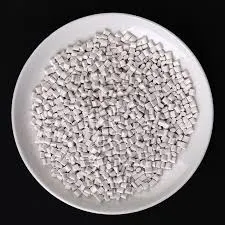The Role of Additives in Plastic Compounding
Plastic compounding is a crucial process in the manufacturing industry, affecting the performance, durability, and functionality of plastic products. This involves blending polymer resins with various additives to achieve desired characteristics. Additives play a pivotal role in enhancing the properties of plastics, making them suitable for a wide array of applications. This article delves into the significance of additives in plastic compounding, focusing on their types, functions, and the benefits they bring to the table.
Types of Additives
Additives in plastic compounding can be categorized into several groups based on their functions
1. Fillers These materials, such as talc, calcium carbonate, or fiberglass, are added to improve mechanical strength, reduce production costs, and enhance thermal properties. Fillers can also modify the density and rigidity of plastics, making them suitable for specific applications.
2. Plasticizers These are used to increase the flexibility and workability of plastic materials. Common plasticizers like phthalates and bio-based alternatives help in reducing the glass transition temperature of polymers, thus increasing their pliability for applications like films, cables, and toys.
3. Stabilizers To enhance the thermal and ultraviolet stability of plastics, stabilizers are added. They help in protecting the polymer matrices from degradation due to heat and exposure to sunlight. Common stabilizers include antioxidants and UV absorbers, which prolong the life and aesthetic appeal of products.
4. Flame Retardants Safety is a primary concern in many applications, and flame retardants are crucial in compounding when fire resistance is needed. These additives reduce the flammability of plastics, making them safer for use in electronics, vehicles, and construction materials.
5. Colorants Dyes and pigments are vital in achieving the desired color and appearance of plastic products. Colorants also contribute to the aesthetic value of consumer goods, ensuring they meet market trends and consumer preferences.
6. Processing Aids These additives improve the processing characteristics of plastics during manufacturing. Processing aids reduce viscosity, improve flow properties, and enhance the performance of polymers during extrusion and molding.
Functions of Additives
plastic compounding additives

The functions of additives in plastic compounding extend beyond just improving performance. They play essential roles in
- Enhancing Mechanical Properties By incorporating various fillers and reinforcements, manufacturers can tailor the mechanical properties of plastics to withstand specific stresses and strains, thus expanding application horizons
.- Improving Processing Efficiency Additives like processing aids contribute to smoother, faster manufacturing processes, reducing costs and time in production.
- Ensuring Product Longevity Stabilizers and flame retardants ensure that plastics can withstand environmental stresses and retain their properties over time, leading to products with longer lifespans.
- Aesthetic Appeal Colorants not only make products visually appealing but also allow brands to differentiate themselves in a crowded market through creative designs.
Benefits of Using Additives
The integration of additives in plastic compounding offers significant benefits, including
- Cost-Effectiveness Using fillers can reduce the amount of expensive polymer resin needed, which can lower overall material costs.
- Customization Additives enable the customization of plastics for specific applications, ensuring they meet industry standards and consumer demands.
- Sustainability As industries move towards more eco-friendly practices, the development of bio-based additives highlights the potential for sustainable compounding, meeting regulatory requirements and consumer preferences for greener products.
In conclusion, additives are indispensable in plastic compounding, enhancing the properties and functionality of plastic products. With ongoing advancements in additive technologies, manufacturers are better equipped to meet the challenges of a dynamic market while ensuring safety, durability, and aesthetic appeal. As the world continues to innovate, the importance of these additives will only grow, paving the way for smarter, more efficient plastic solutions.

